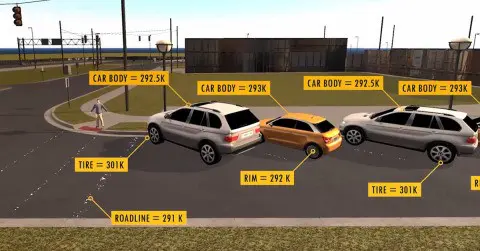
FLIR to Integrate a Thermal Sensor into ANSYS’ Leading-Edge Driving Simulator to Model, Test, and Validate Thermal Imaging for Autonomous Vehicle Development
Ansys and FLIR announced a collaboration to integrate a thermal sensor into driving simulator to model, test, and validate thermal camera designs within an ultra-realistic virtual world. Real-time thermal camera simulation allows developers to test automatic emergency braking systems and autonomous vehicles. (Photo: Business Wire)
The new solution will reduce original equipment manufacturers’ (OEM) development time by optimizing thermal camera placement for use with tools such as automatic emergency braking (AEB), pedestrian detection, and within future AVs.
Having the ability to test in virtual environments complements the existing systems available to FLIR customers and partners, including the FLIR automotive development kit (ADK™) featuring a FLIR Boson® thermal camera, the FLIR starter thermal dataset and the regional, city-specific thermal datasets. The FLIR thermal dataset programs were created for machine learning in advanced driver assistance development (ADAS), AEB, and AV systems.
The current AV and ADAS sensors face challenges in darkness or shadows, sun glare and inclement weather such as most fog. Thermal cameras, however, can effectively detect and classify objects in these conditions. Integrating FLIR Systems’ thermal sensor into ANSYS® VRXPERIENCE® enables simulation of thousands of driving scenarios across millions of miles in mere days. Furthermore, engineers can simulate difficult-to-produce scenarios where thermal provides critical data, including detecting pedestrians in crowded, low-contrast environments.
“By adding ANSYS’ industry-leading simulation solutions to the existing suite of tools for physical testing, engineers, automakers, and automotive suppliers can improve the safety of vehicles in all types of driving conditions,” said Frank Pennisi, President of the Industrial Business Unit at FLIR Systems. “The industry can also recreate corner cases that drivers can see every day but are difficult to replicate in physical environments, paving the way for improved neural networks and the performance of safety features such as AEB.”
“FLIR Systems’ recognizes the limitations of relying solely on gathering machine learning datasets in the physical world to make automotive thermal cameras as safe and reliable as possible for automotive uses,” said Eric Bantegnie, Vice president and General Manager at ANSYS. “Now with ANSYS solutions, FLIR can further empower automakers to speed the creation and certification of assisted-driving systems with thermal cameras.”
In addition to the city-specific data sets, FLIR has more than a decade of experience in the automotive industry. FLIR has provided more than 700,000 thermal sensors as part of its night vision warning systems for a variety of carmakers, including GM, Audi and Mercedes-Benz. Also, FLIR recently announced that its thermal sensor has been selected by Veoneer, a tier-one automotive supplier, for its level-four AV production contract with a top global automaker, planned for 2021.






